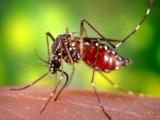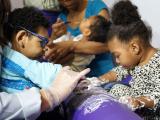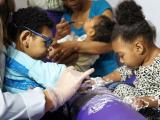The US Centers for Disease Control and Prevention (CDC) today added eight more destinations to its recent Zika virus travel alert, as its experts and those in Europe weighed in on the threat and Brazilian scientists published the first findings from the country's microcephaly task force and registry.
CDC experts said in their assessment of recent developments that although no local transmission has been confirmed in the continental United States, reports of Zika illnesses contracted abroad are likely to increase, which may spark local transmission in limited parts of the country.
Meanwhile experts from the European Centre for Disease Prevention and Control (ECDC), in their fifth risk assessment since February 2014, published a comprehensive report on Zika activity in all parts of the world. It covers advice for health officials, what's known about the possible microcephaly and Guillain-Barre syndrome (GBS) links, travel issues, and screening considerations regarding blood, tissue, and semen donation.
CDC travel list grows
Countries added to the CDC's level 2 travel alert reflect the quickly growing list of locations reporting local spread of the virus. New on the list are Barbados, Bolivia, Ecuador, Guadeloupe, St. Martin, Guyana, Cape Verde, and Samoa, bringing to 22 the number of countries.
The move follows the CDC's initial Jan 15 travel advisory recommending that pregnant women and those trying to become pregnant consider postponing travel to countries where Zika virus is circulating, and if they must travel to the destinations they should follow strict steps to avoid mosquito bites.
Samoa and Cape Verde are two areas where earlier local transmission occurred. The CDC said in its statement that Zika transmission areas can be hard to pinpoint and are likely to change over time and that it would continue to update its travel information as it receives new information.
The agency warned that the Aedes mosquitoes that spread Zika virus, as well as chikungunya and dengue, are aggressive daytime biters that prefer to bite people rather than animals and often live indoors and outdoors near humans.
Not just mosquito-borne
The latest CDC assessment of the most recent developments in the Americas came from experts with its division of vector-borne diseases at its National Center for Emerging and Zoonotic Diseases. They wrote that the two Aedes mosquitoes that can spread Zika virus are found throughout much of the Americas, including parts of the United States.
Their assessment appeared today in Morbidity and Mortality Weekly Report (MMWR).
Aside from disease passed from mosquitoes to people, the virus has also been known to result from intrauterine, intrapartum, sexual, blood transfusion, and lab exposure. There's a theoretical risk from organ and tissue transplantation, and so far breast milk transmission hasn't been documented, though Zika virus RNA has been detected in breast milk, they wrote.
They urged clinicians to consider Zika virus infection in people who have visited an outbreak country within the previous 2 weeks and to consider dengue or chikungunya infection, which have similar symptoms, on the differential diagnosis list.
So far there is no commercially available diagnostic test, and only the CDC and four state labs are equipped to do Zika virus testing. The scientists said the CDC is working to expand testing capacity to more states and that health providers should contact their state or local health department to streamline testing.
The experts emphasized that people with Zika virus infection or other mosquito-borne illness should be protected from mosquito exposure during the first few days of illness to avoid transmitting the virus to local mosquito populations.
Though Zika virus infection isn't currently an officially reportable disease, the CDC experts urge health providers to report suspected cases to state health officials and for states to report lab-confirmed cases to the CDC. They said the agency is working with the Council of State and Territorial Epidemiologists (CSTE) and other groups to come up with a surveillance case definition, mechanisms for reporting cases, and way to monitor the outcomes of pregnant women infected with the virus.
ECDC details public health implications
The ECDC has been grappling with Zika virus since a 2014 event in French Polynesia. In a 24-page risk assessment today, the agency compiled all that is known so far from health ministries, media reports, and the medical literature.
The report highlights the current outbreak hot spots, covers what's known—and not known—about the connections to microcephaly and GBS, and details a range of public health implications, such as the threat from contaminated blood, tissue, and semen donations.
In a rapidly evolving epidemic, hot spots now are 10 countries experiencing increasing and widespread transmission: El Salvador, Venezuela, Colombia, Brazil, Suriname, French Guiana, Honduras, Mexico, Panama, and Martinique. So far sporadic transmission following recent introduction is being reported in Bolivia, Guyana, Ecuador, Guadeloupe, Guatemala, Paraguay, Puerto Rico, Barbados, St. Martin, and Haiti.
The ECDC said Zika detections in travelers hint that local transmission may be occurring in some countries were it hasn't been confirmed yet, including the Maldives and Thailand.
Counts of lab-confirmed cases probably aren't a reliable way to track the intensity and spread of the outbreak, the agency said, because 80% of illnesses are asymptomatic and only a small fraction of the infections are confirmed. It also said it's hard to gauge the true magnitude of the microcephaly problem, because challenges in setting a standard case definition. Though the evidence for a link is growing, so far there's not enough to confirm it or the GBS connection, the report noted.
The spread of the virus and possible connection to severe complications warrants several mitigation steps, however, including increased awareness in travelers and health providers, enhanced vigilance of imported cases, and safety screening of blood, tissue, and semen.
The ECDC recommended that all travelers take extra cautions against mosquito bites and that pregnant women, and those planning on becoming pregnant, consult with their health providers before travel and consider postponing trips to areas of increasing or widespread transmission.
Microcephaly findings from Brazil
Brazilian scientists today published what they learned from investigation into 35 infants born with microcephaly from August to October of 2015 who were part of registry set up by the country's ministry to probe the link between the virus and the birth defect. The findings appear in a second MMWR report.
All of the mothers had lived in a Zika-affected area during their pregnancies; 26 of them reported a rash during the first or second trimesters.
Twenty-five of the 35 babies had severe microcephaly, and 17 had at least one neurologic abnormality. Of 27 infants who underwent neuroimaging studies, all had abnormalities, such as widespread brain calcifications. A third of them had cell-migration abnormalities. Cerebrospinal fluid to test for Zika virus was obtained from all of the infants, but so far results aren't yet available.
The authors concluded that the sudden rise in microcephaly associated with evidence of cerebral damage in a region where a new virus is circulating suggests a possible relationship. Ongoing surveillance is needed to better describe the spectrum of the problem, and more studies—including case-control ones—are needed to confirm the association, define the magnitude, and identify other possible risk factors, the team wrote.
They pointed out four possible limitations of the study, which might include increased reporting, missed mild cases, recall bias connected with a nonspecific rash illness, and lack of characterizing other intrauterine infections.
See also:
Jan 22 CDC press release
Jan 22 MMWR report from CDC on recent Zika spread in the Americas
Jan 22 ECDC Zika virus risk assessment
Jan 22 MMWR report on microcephaly findings






















